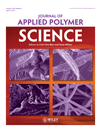Wicking properties of various polyamide nanofibrous structures with an optimized method
Abstract
In comparison with conventional structures, nanofibrous structures have unique characteristics, such as higher surface-to-volume ratios, smaller pores, and higher porosity. Their hydrophilic nature is a key characteristic for many applications. However, because of their high porosity, it is difficult to measure the hydrophilicity of nanofibrous structures with contact-angle measurements. Therefore, characterization through wicking behavior is more appropriate. The International Organization for Standardization norm on wicking needs some refining to account for the specific nature of highly porous nanofibrous structures. A refined method was used on several structures that differed in the fiber diameter and the polyamide type. The structures with the thickest nanofibers had the highest wicking rates. At equilibrium, the wicking heights of structures of different polyamide types with the same average fiber diameter followed the trend expected from their intrinsic hydrophilicity. In the initial phase, the capillary forces established the wicking behavior. Later in the process, the wicking behavior was determined by the capillary forces and the hydrophilicity. In conclusion, the hydrophilicity of nanofibrous structures can be successfully determined by an optimized wicking procedure, and the fiber diameter is the dominant parameter for the resulting wicking height at equilibrium. © 2010 Wiley Periodicals, Inc. J Appl Polym Sci, 2011




